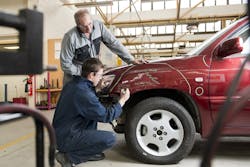I had an interesting conversation recently with a young shop owner who had taken the reins of a large, established shop. He was working on technician recruiting strategies and commented on the conflict of ideas, skills and mindsets he saw between different generations of collision repair professionals.
He valued experience and old-school work ethic and at the same time recognized the worth of tech-savvy, open-minded newcomers to the industry. His business was going through major operational changes, so he needed staff that was not only reliable, skilled and able to get the day-to-day work of repairing vehicles done (older techs), but also those who were not afraid to work in an evolving business determined to break industry stereotypes (younger techs).
The truth is, the whole collision repair industry is evolving more rapidly every day as it tries to keep up with the training, tools and equipment needed to repair more advanced vehicles and their myriad components—and to meet the increasing expectations of customers.
And at the same time, in terms of both consumers and collision repair professionals, we are on the cusp of a major generational shift. A large number of Baby Boomers—our recent “How I Work Survey” found that more than 70 percent of shop operators are over 50 years old—are working alongside, and being replaced by, a growing group of millennials. The survey also found that more than 75 percent of operators have been in the industry for 20 years or more—22 percent have worked in collision repair for 40 or more years!
As we move into 2014 and beyond, these groups of seasoned and green repairers will have to be able to coexist and, hopefully, together ensure the growth and long-term success of the collision repair industry.
With everything that has happened in the last year, in terms of insurer involvement in the repair process, continued consolidation, the reheating of the repair standards discussion, the quickening emergence of alternative-fuel and even autonomous vehicles—to name a few issues—the industry will need professionals from every era to work together. Ideas will be different, repairers will butt heads, but whether it’s in the shop or at industry forums and association meetings, those interactions are an important part of moving forward.
And as shops transition, we’ll be here to help. In this issue alone, you’ll find features on some of the top performing shops in the country, as well as a case study on one facility that saw a $1 million sales dip before revising its approach to customer service. You’ll also find strategies for improving sales through phone etiquette, gaining website traffic and utilizing your all-important profit and loss statement.
We’ll continue to bring you the successes, failures and valuable lessons from industry professionals across the country. And be sure to let us know if you have your own story to share.
Jake Weyer, Editor
[email protected]
